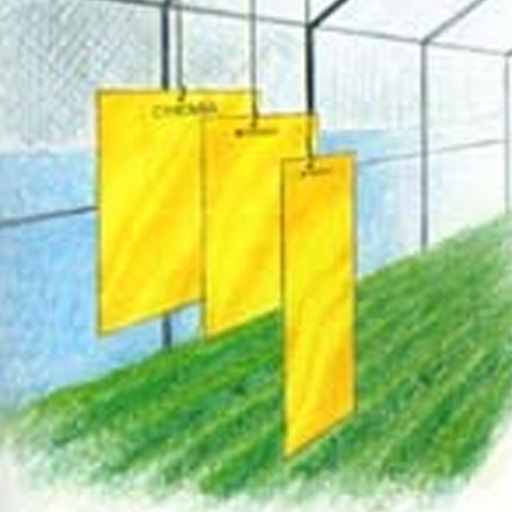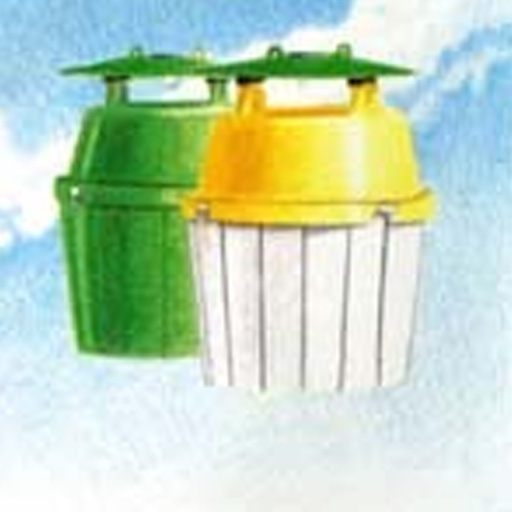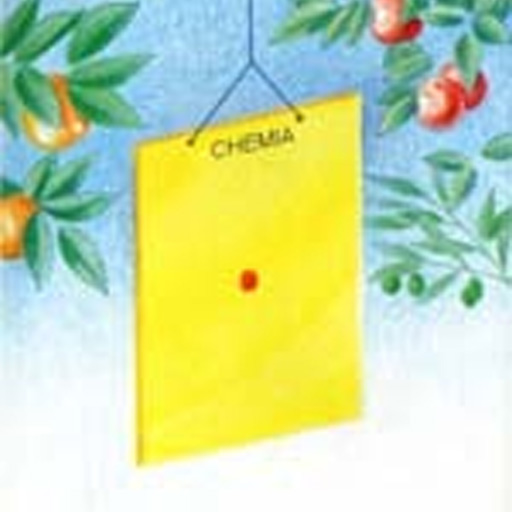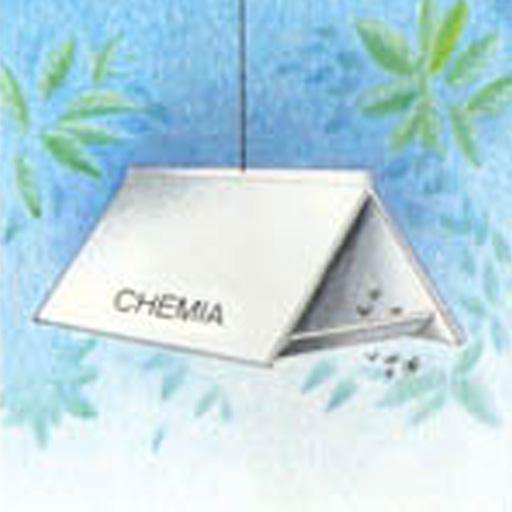Le trappole sessuali, attualmente, rappresentano il sistema più affidabile per evidenziare la presenza dei fitofagi, l’andamento delle popolazioni e i periodi di massimo sfarfallamento degli adulti.
Possono essere impiegate per il monitoraggio o per la cattura massiva degli insetti maschi al fine di diminuire le possibilità di accoppiamento.
Allo scopo di contribuire al progresso della difesa integrata, l’azienda Chemia S.p.A ha messo a punto una vasta gamma di trappole sessuali.
Tutte le trappole di Chemia sono ammesse in Agricoltura Biologica.
Sono trappole cromotropiche ricoperte di una colla speciale che non secca.
Il principio di funzionamento delle trappole BIOCATTURA V è basato sull’attrazione che il colore giallo esercita nei confronti degli insetti alati come afidi, tripidi, mosche, mosche bianche, moscerini, minatori fogliari, ecc.
Le trappole possono essere usate sia in pieno campo che in serra. In pieno campo sono sufficienti 3-5 trappole/Ha per evidenziare la presenza degli insetti.
Negli ambienti protetti si consiglia di disporre le trappole poco sopra l’apice vegetativo delle piante in numero di 1 ogni 10-15 mq di superficie.
Quando la trappola è completamente ricoperta dagli insetti catturati o da altre impurità, si deve provvedere alla sostituzione.
DIMENSIONI:
cm. 20 x 22 in 10 pezzi uniti
cm. 10 x 25 in 5 pezzi uniti
cm. 10 x 30 in 10 pezzi separati.


BIOCATTURA è una trappola sessuale onnidirezionale in plastica rigida ideale per la cattura massiva degli insetti volanti negli ambienti chiusi, in pieno campo, parchi, giardini, foreste, ecc.
La trappola, multistagionale, è composta da tre parti:
- una parte superiore con apposito attacco per i vari tipi di Feromone;
- una parte intermedia ad imbuto;
- una parte inferiore per la raccolta degli insetti catturati.
La trappola è facilmente montabile e smontabile in quanto provvista di appositi attacchi ed incastri.
DIMENSIONI: 230 mm di altezza x 170 mm di diametro.


Sono trappole cromotropiche ricoperte di colla che non secca la cui efficacia di cattura è dovuta all’attrazione che il Feromone specifico ed il colore giallo esercitano nei confronti dei fitofagi.
Le trappole sessuali BIOCONTROL V costituiscono un valido sistema di monitoraggio per valutare, in seguito alla cattura degli adulti, il momento più opportuno per intervenire con i prodotti chimici. Si consiglia di usare le trappole nel numero di 3/Ha più una per ogni ettaro successivo.
Quando la trappola è completamente ricoperta dagli insetti catturati, si deve provvedere alla sostituzione.
Può essere impiegata con una vasta gamma di Feromoni.
DIMENSIONI: cm. 20 x 22.


La BIOCONTROL DELTA è una trappola sessuale bidirezionale versatile in plastica pieghevole ideale per la cattura ed il monitoraggio degli insetti alati.
Grazie alla presenza di una base collosa mobile, la trappola è facilmente ispezionabile senza dover essere smontata.
Il Feromone deve essere posto al centro della base collosa. La trappola viene impiegata indifferentemente sia negli ambienti chiusi che in pieno campo.
Se ne consiglia l’impiego in quelle aree dove la polvere può costituire un serio inconveniente.
La BIOCONTROL DELTA può essere utilizzata con una vasta gamma di Feromoni.
IMBALLAGGI: disponibile in confezioni singole o in scatole da 3 trappole.


I feromoni sono sostanze prodotte dalle ghiandole esocrine degli animali. Costituiscono un messaggio chimico che, ricevuto da un altro individuo della stessa specie, ne provoca una reazione.
I feromoni sessuali liberati nell’atmosfera dalle femmine degli insetti costituiscono un elemento indispensabile nella loro riproduzione.
Attualmente, i feromoni sessuali vengono prodotti per sintesi ed impiegati in trappole per il controllo degli insetti dannosi.
L’Azienda Chemia S.p.A. dispone di un elevato numero di feromoni di sintesi per la difesa e il controllo di una vasta gamma di insetti, ammessi in agricoltura biologica:
AGROTIS IPSILON (BLACK CUTWORM) = Nottua Ipsilo
AGROTIS SEGETUM (TURNIP MOTH) = Nottua dei Seminati
ANARSIA LINEATELLA (PEACH TWIG BORER) = Tignola del Pesco
ARCHIPS PODANA (FRUIT TREE TORTRIX) = Cacoecia dei Frutti
ARGYROTAENIA PULCHELLANA (FRUIT TREE TORTRIX MOTH) = Eulia
CACOECIMORPHA PRONUBANA (CARNATION TORTRIX MOTH) = Bega del garofano
CERATITIS CAPITATA (MEDITERRANEAN FRUIT FLY) = Mosca della frutta
CYDIA POMONELLA (CODLING MOTH) = Carpocapsa pomonella
COSSUS COSSUS (EUROPEAN GOAT MOTH) = Rodilegno rosso
CYDIA MOLESTA (ORIENTAL FRUIT MOTH) = Tignola orientale del pesco
DACUS OLEAE (OLIVE FLY) = Mosca dell’olivo
DIABROTICA VIRGIFERA
EPHESTIA KUENNIELLA (MEDITERRANEAN FLOUR MOTH) = Tignola della farina
EPICHORISTOIDES ACERBELLA (SOUTH AFRICAN CARNATION TORIR IX) = Bega Sudafricana del Garofano
EUPOECILIA AMBIGUELLA (FUROPEAN GRAPE BERRY MOTH) = Tignola dell’uva
HELIOTHIS ARMIGERA (OLD WORLD BUDWORM/COTTON BURDWORM) = Nottua del pomodoro
LASPEYRESIA FUNEBRANA (PLUM FRUIT FLY) = Tignola delle Susine
LITHOCOLLETIS BLANCARDELLA = Litocollete
LOBESIA BOTRANA (EUROPEAN GRAPE WINE MOTH) = Tignoletta dell’uva
LYMANTRIA DISPAR (GYPSY MOTH) = Limantria o Bombice dispari
ORGYA ANTIQUA (RUSTY TUSSOCK MOTH) = Orgia o Bombice antico OSTRINIA NUBILALIS
(EUROPEAN CORN BORER) = Piralide del mais
PANDEMIS CERASANA (FRUIT TREE TORTRIX MOTH) = Pandemis o Ricamatrice frutti
PLODIA INTERPUNCTELLA (INDlAN MEAL MOTH) = Tignola fasciata
PRAYS CITRI Tignola degli agrumi
PRAYS OLEAE (OLIVE MOTH) = Tignola dell’olivo
RHAGOLETIS SPP (FRUIT FLY) = Mosca della frutta
SCOLYTUS MULTISTRIATUS (EUROPEAN ELM BARK REETLE) = Scolitide dell’olmo
SITOTROGA CEREALELLA (ANGOMOUMIS GRAIN MOTH) = Vera Tignola del grano
SYNANTHEDON MYOPAEFORMIS (APPLE CLEARWING MOTH) = Sesia del melo
THAUMETOPOEA PITYOCAMPA (PINE PROCESSIONARY MOTH) = Processionaria del pino
ZEUZERA PYRINA = Rodilegno giallo
Chemia S.p.a. - P.IVA 00040080384 - Registration number 00040080384 at Registro Imprese di Ferrara - Share Capital € 826.400,00 I.V. - Privacy Policy - Cookie Policy - Credits